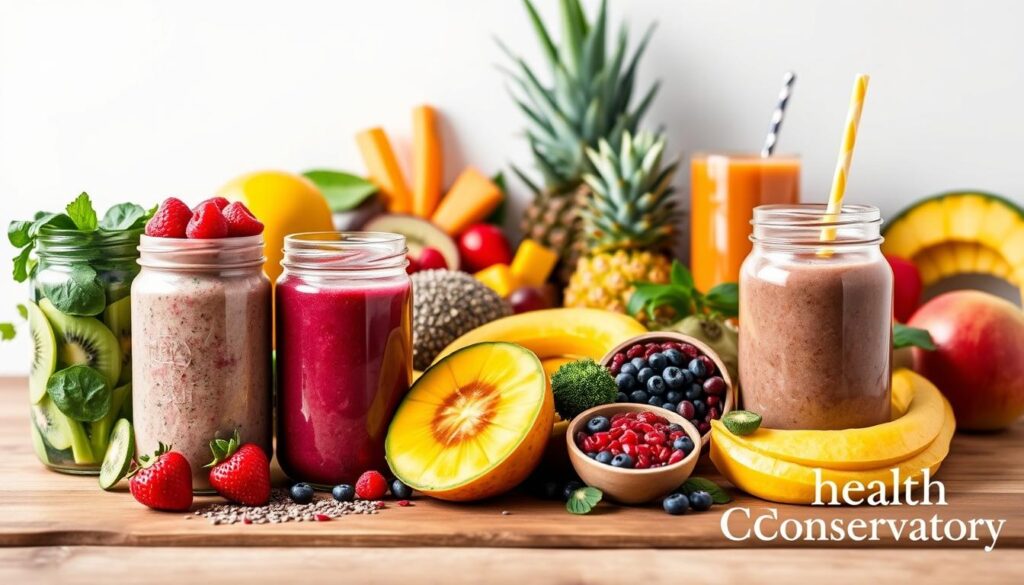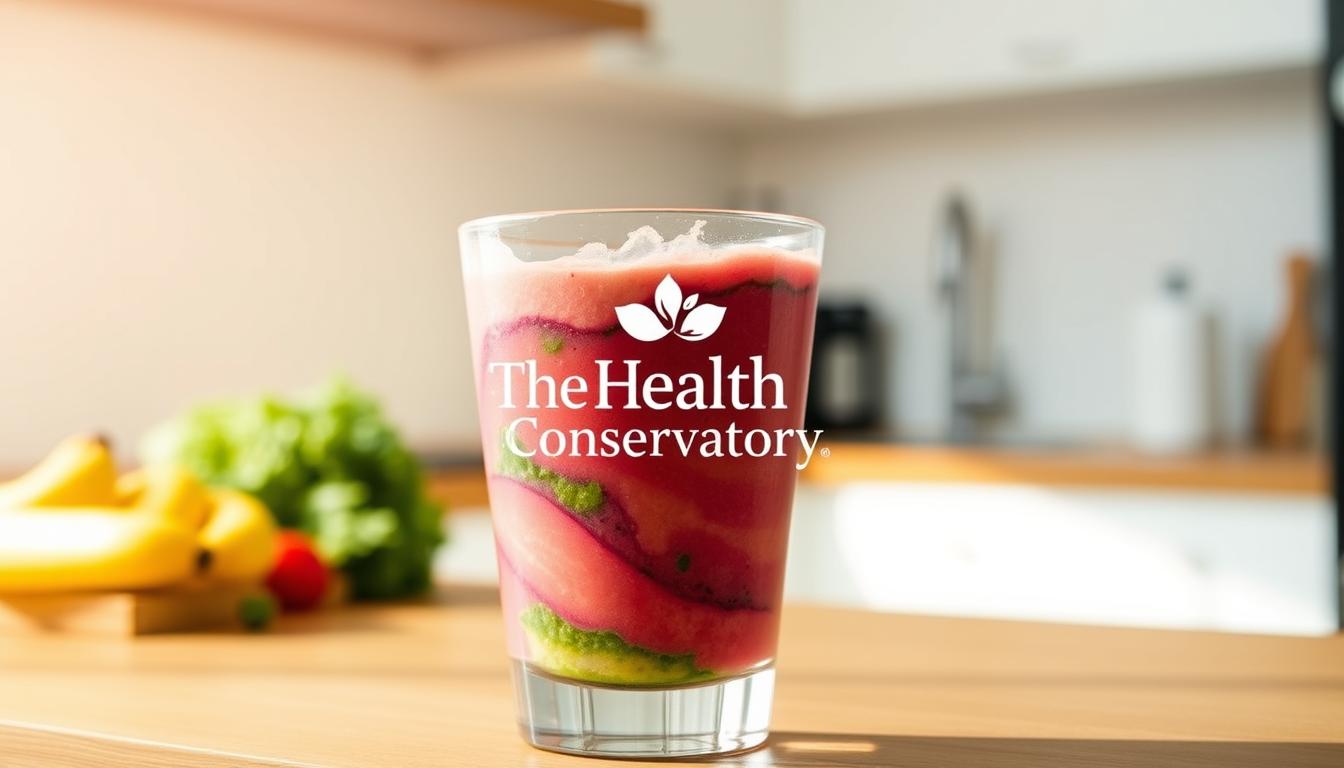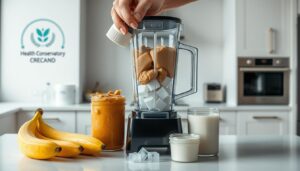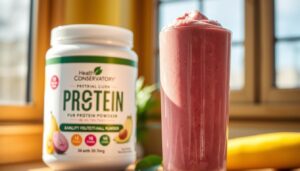Can You Make a Smoothie with Water is the question many vegans ask when they want a light, dairy-free drink that still tastes great.
Yes, water can be the base for a tasty, creamy blend if you choose the right ingredients and technique.
Start with liquid first, then frozen fruit, and blend low to high for about 50–60 seconds for silkier texture. Use frozen bananas or frozen fruit instead of ice to avoid dilution. Add-ins like chia, flax, or plant protein boost nutrition and mouthfeel without dairy.
Practical tip: Many cooks like half juice and half water for extra flavor. Store jars in the fridge up to 24 hours or prep freezer packs for quick mornings. If you need ideas, try our Smoothie Generator to craft vegan, water-based recipes fast: https://healthconservatory.com/smoothie-generator.
Key Takeaways
- Water works as a base when paired with frozen fruit and creamy add-ins.
- Add liquid first, then frozen fruit; blend low to high for best texture.
- Frozen bananas and plant add-ins add creaminess without dairy.
- Avoid ice to prevent watery blends; use frozen fruit instead.
- Prep jars and freezer packs to save time on busy mornings.
- Use a powerful blender like Vitamix for consistent results.
Can You Make a Smoothie with Water: What You Need to Know Today
Water makes a clean, neutral base that lets produce flavor take center stage. Use this approach when you want a lighter, lower-calorie drink that still tastes fresh. Start by measuring about 3/4 to 1 cup of liquid per serving and add more if needed.
Why water works as a base for vegan blends
Water hydrates without adding fat. It lets ripe fruit and leafy greens show their true taste. Frozen fruits create body and avoid dilution better than ice.
When to choose water over plant milk
Pick water when you want a brighter, fresher flavor or fewer calories. Choose plant milk—almond or oat—if you want extra creaminess or a richer mouthfeel. For dairy-like texture without greek yogurt, add avocado, oats, or nut butter.
| Feature | Water | Plant milk |
|---|---|---|
| Calories | Low (0) | Varies (30–120) |
| Effect on flavor | Lets fruit and greens shine | Adds subtle nuttiness or cream |
| Texture | Light; needs frozen fruit for body | Smoother; more body |
| Best for | Fresh, bright recipes; making smoothies on a budget | Creamy, dessert-style blends |
- Tip: Mix half water, half juice for mild sweetness without refined sugar.
- Tip: Add spinach or kale; they blend into berries and won’t overpower flavor.
Your Vegan-Friendly Liquid and Ingredient Playbook
Choose a light, neutral liquid when you want fruit flavors to lead the blend. Use water, coconut water, or thin plant milk to keep calories low and flavor bright.
Water vs. plant milks
Water gives a clean base; almond, oat, cashew, or coconut milk add creaminess when you want more body. Pick milk for dessert-style blends and water for fresh, low-fat recipes.
Fruits and frozen fruit that work best
Prioritize bananas, mango, pineapple, strawberries, blueberries, and cherries. Frozen fruit builds texture without dilution—better than ice.
Greens and creaminess boosters
Add spinach, kale, or Swiss chard; berries tame the earthiness. For plant-based creaminess, use banana, avocado, or a spoon of nut butter.
Vegan protein options
Boost protein with chia, ground flax, hemp, or a scoop of pea or hemp protein powder. Balance fiber and healthy fat to make smoothies more satisfying.
- Prep mixed fruits and greens in freezer bags for quick blends.
- Start the blender low, ramp to high—Vitamix excels with frozen produce.
How to Make a Water-Based Smoothie Step by Step
https://www.youtube.com/watch?v=9QBVaQdCrZA
Begin by pouring the water into the blender so the blades grab and pull down your frozen fruit and greens.
Layering matters: add frozen fruit next, then leafy greens, and finally any powders, seeds, or nut butter. This order prevents clogs and speeds blending.
Start low, then ramp up. Put the lid on, start the blender at low speed, and increase to high. High-powered machines reach a silky texture in about 50–60 seconds of total time.
Begin with roughly 3/4 to 1 cup of liquid per serving. If the jar stalls, add small splashes until the blades move freely.
Avoid ice; it dilutes flavor and makes drinks icy instead of creamy. Use frozen fruit to chill and thicken without watering down the blend.
- If the mix is too thin, add a banana chunk or more frozen fruit.
- For extra creaminess on a water base, blend in oats, avocado, or nut butter.
- Add protein powder after a quick pulse to prevent clumping, then finish with a short blend and taste for brightness.
Dialing In Texture, Sweetness, and Flavor
A few pantry ingredients deliver creaminess and natural sweetness without dairy. Use them to turn a light blend into something satisfying while keeping calories and fat low.
How to thicken without dairy
Frozen bananas are the quickest trick. Even half a banana adds frosty body and a creamy mouthfeel when water is the liquid.
Oats add soluble fiber and thickness. Start with 1–2 tablespoons per serving and blend until smooth.
A spoon of nut butter gives richness and staying power. Almond or peanut butter boosts healthy fat and helps the texture hold up longer.
Natural ways to sweeten and boost flavor
Ripe fruit and dates are excellent for sweetness. A small date lends caramel notes, while mango brightens the blend without added sugar.
A touch of maple or a tiny drizzle of honey can round tart berries. If you usually rely on yogurt or greek yogurt, try silken tofu, avocado, or extra frozen banana instead to keep things vegan.
“Small tweaks — another chunk of frozen fruit, a spoonful of oats, or a bit of nut butter — make all the difference.”
- Keep ice minimal: frozen fruit chills without diluting flavor.
- Protein tip: add a finely milled plant protein after a quick blend to avoid grittiness.
- Taste and adjust: add another banana chunk for body or a date for more sweetness.
Sample Vegan Smoothie Recipes Using Water
These sample recipes show how minimal ingredients deliver big flavor on a water base. Each formula uses cold water first, then frozen fruit, and a short blend for best texture.
Strawberry banana smoothie with water and peanut butter
Ingredients: 3/4 cup cold water, 1 to 1 1/2 cups frozen strawberries and frozen bananas, 1/2 frozen banana, 1 tbsp peanut butter.
Start with the water, add frozen fruit, then peanut butter. Blend until smooth. Sweeten with a date or a drizzle of maple if needed.
Green smoothie: spinach, pineapple, and frozen banana
Ingredients: 3/4 cup cold water, 1 packed cup spinach, 1 cup frozen pineapple, 1/2 frozen banana.
Pour in water first, add greens and frozen fruit. The banana adds creaminess without dairy. A squeeze of lime brightens the mix.
Tropical blend: mango, pineapple, and a squeeze of orange
Ingredients: 3/4 cup cold water, 1 to 1 1/2 cups frozen mango and pineapple, splash of orange juice or a squeeze of fresh orange.
Begin with water, then frozen fruit, and finish with citrus. For extra body, drop in a small piece of avocado or another banana chunk.
- Storage: Refrigerate leftovers up to 24 hours or freeze for 1–2 months.
- Freeze bananas in chunks for a creamier banana smoothie every time.
- Garnish with berries or a sprinkle of chia for fiber and omega-3s.
“Small swaps — more frozen fruit, a spoon of nut butter, or a squeeze of citrus — lift flavor and texture on a water base.”
Time-Savers: Prep, Storage, and Freezer Packs
Prep simple freezer packs so mornings take minutes instead of half an hour. With a little planning, you can have ready-to-blend portions that cut morning fuss.
Fridge storage: Pour finished drinks into mason jars, seal, and refrigerate up to 24 hours. Ingredients may separate; shake before serving to restore texture.
For longer holds, freeze portions in bags or containers. They keep 1–2 months and thaw best overnight in the fridge. To speed-thaw, run the sealed bag briefly under warm water, then blend.
Freeze and pack like a pro
- Pre-portion freezer packs: add frozen fruit, banana chunks, and greens to each bag. Label with contents and suggested water amount (for example, “Add 3/4 cup”).
- Freeze fruit properly: rinse, chop, pat dry, freeze on a parchment-lined sheet for about two hours, then transfer to bags to prevent clumping.
- Freeze bananas in halves or thirds for creamier blends and shorter blend time.
- Freeze greens loose or puree with a splash of water and freeze in ice cube trays to save space.
Quick routine: In the morning, add water to the blender first, dump in a pack, and blend. This system saves serious time and keeps your vegan routine consistent.
Blenders and Tools That Make Smoothies Easy
Choose a blender built for frozen loads so fruit and greens move smoothly without stalling. That single choice saves time and keeps texture consistent.
What to look for in a blender for frozen fruit
Power, blade design, and a wide base create a vortex that pulls frozen ingredients into the blades. Models like Vitamix handle heavy frozen loads, while Waring professional blenders are a solid budget alternative.
Measuring cups, jars, and freezer-safe bags that help
Keep a set of measuring cups to portion liquid—start with about one cup per serving. Use mason jars for fridge storage and labeled freezer bags for pre-portioned packs.
| Tool | Role | Benefit |
|---|---|---|
| High-power blender | Blend frozen fruit, greens | Smooth texture; fewer stalls |
| Tamper | Loosen thick packs | Faster blend; less air |
| Mason jars & bags | Store recipes and packs | Save time; easy rotation |
“Start low, ramp to high, and blend about 50–60 seconds for a silky finish.”
- Store almond milk or powder in small containers for quick add-ins.
- Label packs with date and main ingredients to manage the freezer well.
- Rinse your blender after use and deep-clean weekly to protect blades and flavor.
Common Myths and Mistakes About Water-Based Smoothies
Missteps like overloading ice or excess liquid are the main causes of thin, icy drinks. Start by trusting frozen fruit and frozen strawberries to chill and thicken without watering down flavor.
Myth: milk or yogurt is required for creaminess. Truth: banana, avocado, oats, or silken tofu build body while keeping the base light.
Mistake: adding lots of ice. Use frozen fruit instead to protect flavor and improve texture.
- Start with less liquid: add water only if the blender stalls.
- Hide greens: pair spinach with berries to keep taste mild.
- Include healthy fat: a teaspoon of nut butter or chia boosts satiety.
| Belief | Why it’s wrong | Quick fix |
|---|---|---|
| You need milk | Milk adds fat, not always needed | Use banana or avocado for cream |
| Ice thickens | Ice dilutes flavor and ruins texture | Use frozen fruit for chill and body |
| Greens taste bitter | Strong only when unbalanced | Mix with berries or frozen strawberries |
“Small swaps—more frozen fruit, a spoon of oats, or a bit of nut butter—make all the difference.”
Try Our Smoothie Generator for Vegan Smoothie Recipes

Generate custom, pantry-friendly vegan blends in seconds using our online tool. It builds balanced recipes that use water as the base and match the items on your shelves.
Create custom water-based smoothie recipes in seconds
Tell the generator which fruit, greens, and add-ins you have and it returns precise proportions per cup. Pick mango, pineapple, berries, or frozen banana and get recipes that balance texture and sweetness.
Get ideas tailored to your fruit, greens, and protein on hand
Ask for a strawberry banana smoothie, a banana smoothie with peanut butter, or a citrus green smoothie. The tool recommends when to add protein powder or a splash of juice to brighten flavor without over-sweetening.
- Instantly create vegan, water-based smoothie recipes: https://healthconservatory.com/smoothie-generator
- Choose creamy or lighter textures and receive step-by-step instructions that start by adding water first.
- Save, print, or share recipes to streamline mornings and reduce food waste.
“Try it now to unlock new flavor combinations and consistent texture that fit what’s in your kitchen.”
Conclusion
, In short: a water-based smoothie can be creamy, bright, and filling when you use frozen fruit, ripe banana, and simple boosters like oats or avocado.
Start by layering liquid, frozen fruit, and add-ins, then blend low to high until silky. Swap fruits to keep flavors lively and prep freezer packs so mornings move fast.
For extra protein, choose pea or hemp powder and add it near the end for smooth texture. This post gives a full playbook; now experiment with proportions until the recipe fits your routine.
Try the Smoothie Generator: visit https://healthconservatory.com/smoothie-generator for custom smoothie recipes that match your fruit, bananas, and pantry — then blend and enjoy.




